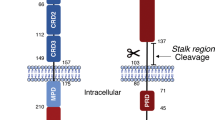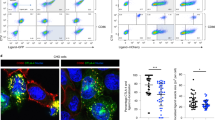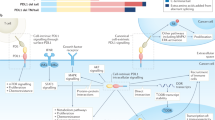Abstract
Apoptosis in the immune system is a fundamental process regulating lymphocyte maturation, receptor repertoire selection and homeostasis. Thus, death by apoptosis is as essential for the function of lymphocytes as growth and differentiation. This article focuses on death receptor-associated apoptosis and the role of CD95 (Apo-1/Fas)-mediated signalling in T-cell and B-cell development and during the course of an immune response. Gaining an insight into these processes improves our understanding of the pathogenesis of diseases such as cancer, autoimmunity and AIDS, and opens new approaches to rational treatment strategies.
This is a preview of subscription content, access via your institution
Access options
Subscribe to this journal
Receive 51 print issues and online access
$199.00 per year
only $3.90 per issue
Buy this article
- Purchase on Springer Link
- Instant access to full article PDF
Prices may be subject to local taxes which are calculated during checkout




Similar content being viewed by others
References
Tonegawa, S. Somatic generation of antibody diversity. Nature 302 , 575–581 (1983).
Craxton, A., Otipoby, K. L., Jiang, A. & Clark, E. A. Signal transduction pathways that regulate the fate of B lymphocytes. Adv. Immunol. 73, 79–152 (1999).
Sebzda, E. et al. Selection of the T cell repertoire. Annu. Rev. Immunol. 17, 829–874 ( 1999).
Drakesmith, H., Chain, B. & Beverley, P. How can dendritic cells cause autoimmune disease? Immunol. Today 21, 214–217 (2000).
DosReis, G. A. & Shevach, E. M. Peripheral T-cell self-reactivity and immunological memory. Immunol. Today 19, 587–588 (1998).
Berzins, S. P., Godfrey, D. I., Miller, J. F. & Boyd, R. L. A central role for thymic emigrants in peripheral T cell homeostasis. Proc. Natl Acad. Sci. USA 96, 9787– 9791 (1999).
Krammer, P. H. CD95(APO-1/Fas)-mediated apoptosis: live and let die. Adv. Immunol. 71, 163–210 ( 1999).
Peter, M. E., Scaffidi, C., Medema, J. P., Kischkel, F. C. & Krammer, P. H. In Apoptosis, Problems and Diseases (ed. Kumar, S.) 25–63 (Springer, Heidelberg, 1998).
Marsters, S. A. et al. Interaction of the TNF homologues BLyS and APRIL with the TNF receptor homologues BCMA and TACI. Curr. Biol. 10, 785–788 (2000).
Cascino, I., Fiucci, G., Papoff, G. & Ruberti, G. Three functional soluble forms of the human apoptosis-inducing Fas molecule are produced by alternative splicing. J. Immunol. 154, 2706 –2713 (1995).
Klas, C., Debatin, K. M., Jonker, R. R. & Krammer, P. H. Activation interferes with the APO-1 pathway in mature human T cells. Int. Immunol. 5, 625–630 (1993).
Leithäuser, F. et al. Constitutive and induced expression of Apo-1, a new member of the nerve growth factor/tumor necrosis factor receptor superfamily, in normal and neoplastic cells. Lab. Invest. 69, 415 (1993).
Golstein, P. Controlling cell death. Science 275, 1081 –1082 (1997).
Medema, J. P. et al. Cleavage of FLICE (caspase-8) by granzyme B during cytotoxic T lymphocyte-induced apoptosis. Eur. J. Immunol. 27 , 3492–3498 (1997).
Martinez-Lorenzo, M. J. et al. Activated human T cells release bioactive Fas ligand and APO2 ligand in microvesicles. J. Immunol. 163, 1274–1281 (1999).
Li, J. H. et al. The regulation of CD95 ligand expression and function in CTL . J. Immunol. 161, 3943– 3949 (1998).
Mariani, S. M., Matiba, B., Bäumler, C. & Krammer, P. H. Regulation of cell surface APO-1/Fas (CD95) ligand expression by metalloproteases . Eur. J. Immunol. 25, 2303– 2307 (1995).
Tanaka, M. et al. Fas ligand in human serum. Nature Med. 2, 317–322 (1996).
Yagita, H. et al. Fas-mediated cytotoxicity — a new immunoregulatory and pathogenic function of Th1 CD4+ T cells. Immunol. Rev. 146, 223–239 (1995).
Tanaka, M., Suda, T., Takahashi, T. & Nagata, S. Expression of the functional soluble form of human fas ligand in activated lymphocytes. EMBO J. 14, 1129–1135 ( 1995).
Suda, T., Hashimoto, H., Tanaka, M., Ochi, T. & Nagata, S. Membrane Fas ligand kills human peripheral blood T lymphocytes, and soluble Fas ligand blocks the killing. J. Exp. Med. 186, 2045–2050 (1997).
Kischkel, F. C. et al. Cytotoxicity-dependent APO-1 (Fas/CD95)-associated proteins form a death-inducing signaling complex (DISC) with the receptor. EMBO J. 14, 5579–5588 ( 1995).
Muzio, M. et al. FLICE, a novel FADD-homologous ICE/CED-3-like protease, is recruited to the CD95 (Fas/APO-1) death-inducing signaling complex. Cell 85, 817–827 ( 1996).
Siegel, R. M. et al. Fas preassociation required for apoptosis signaling and dominant inhibition by pathogenic mutations. Science 288, 2354–2357 (2000).
Chan, F. K. et al. A domain in TNF receptors that mediates ligand-independent receptor assembly and signaling. Science 288, 2351–2354 (2000).
Scaffidi, C. et al. Two CD95 (APO-1/Fas) signaling pathways. EMBO J. 17, 1675–1687 ( 1998).
Luo, X., Budihardjo, I., Zou, H., Slaughter, C. & Wang, X. Bid, a Bcl2 interacting protein, mediates cytochrome c release from mitochondria in response to activation of cell surface death receptors. Cell 94, 481– 490 (1998).
Li, H., Zhu, H., Xu, C. & Yuan, J. Cleavage of BID by caspase 8 mediates the mitochondrial damage in the Fas pathway of apoptosis . Cell 94, 491–501 (1998).
Kroemer, G. The pharmacology of T cell apoptosis. Adv. Immunol. 58, 211–296 (1995).
Du, C., Fang, M., Li, Y., Li, L. & Wang, X. Smac, a mitochondrial protein that promotes cytochrome c-dependent caspase activation by eliminating IAP inhibition. Cell 102, 33–42 (2000).
Verhagen, A. M. et al. Identification of DIABLO, a mammalian protein that promotes apoptosis by binding to and antagonizing IAP proteins. Cell 102, 43–53 (2000).
Yin, X. M. et al. Bid-deficient mice are resistant to Fas-induced hepatocellular apoptosis. Nature 400, 886– 891 (1999).
Thome, M. et al. Viral Flice-inhibitory proteins (FLIPs) prevent apoptosis induced by death receptors. Nature 386, 517– 521 (1997).
Hu, S. et al. A novel family of viral death effector domain-containing molecules that inhibit both CD-95- and tumor necrosis factor receptor-1-induced apoptosis . J. Biol. Chem. 272, 9621– 9624 (1997).
Bertin, J. et al. Death effector domain-containing herpesvirus and poxvirus proteins inhibit both Fas- and TNFR1-induced apoptosis. Proc. Natl Acad. Sci. USA 94, 1172–1176 (1997).
Yeh, W. C. et al. Requirement for Casper (c-FLIP) in regulation of death receptor-induced apoptosis and embryonic development. Immunity 12, 633–642 (2000).
Bodmer, J. L. et al. TRAIL receptor-2 signals apoptosis through FADD and caspase-8 . Nature Cell Biol. 2, 241– 243 (2000).
Sprick, M. R. et al. FADD/MORT1 and caspase-8 are recruited to TRAIL receptors 1 and 2 and are essential for apoptosis mediated by TRAIL receptor 2. Immunity 12, 599–609 ( 2000).
Kischkel, F. C. et al. Apo2L/TRAIL-dependent recruitment of endogenous FADD and caspase-8 to death receptors 4 and 5. Immunity 12, 611–620 (2000).
Chen, W. F., Scollay, R., Clark-Lewis, I. & Shortman, K. The size of functional T-lymphocyte pools within thymic medullary and cortical cell subsets. Thymus 5, 179– 195 (1983).
Surh, C. D. & Sprent, J. T-cell apoptosis detected in situ during positive and negative selection in the thymus. Nature 372, 100–103 ( 1994).
Amsen, D. & Kruisbeek, A. M. Thymocyte selection: not by TCR alone. Immunol. Rev. 165, 209– 229 (1998).
Kishimoto, H. & Sprent, J. The thymus and central tolerance . Clin. Immunol. 95, S3– S7 (2000).
Newton, K., Harris, A. W. & Strasser, A. FADD/MORT1 regulates the pre-TCR checkpoint and can function as a tumour suppressor. EMBO J. 19, 931–941 (2000).
Krammer, P. H. & Debatin, K. M. When apoptosis fails. Curr. Biol. 2, 383– 385 (1992).
Kishimoto, H., Surh, C. D. & Sprent, J. A role for Fas in negative selection of thymocytes in vivo. J. Exp. Med. 187, 1427– 1438 (1998).
Aiello, S. et al. Thymic dendritic cells express inducible nitric oxide synthase and generate nitric oxide in response to self- and alloantigens. J. Immunol. 164, 4649–4658 (2000).
Nelson, B. H. & Willerford, D. M. Biology of the interleukin-2 receptor. Adv. Immunol. 70, 1– 81 (1998).
Dhein, J., Walczak, H., Bäumler, C., Debatin, K. M. & Krammer, P. H. Autocrine T-cell suicide mediated by APO-1/(Fas/CD95). Nature 373, 438– 441 (1995).
Alderson, M. R. et al. Fas ligand mediates activation-induced cell death in human T lymphocytes. J. Exp. Med. 181, 71– 77 (1995).
Brunner, T. et al. Cell-autonomous Fas (CD95)/Fas-ligand interaction mediates activation-induced apoptosis in T-cell hybridomas. Nature 373, 441–444 (1995).
Ju, S. T. et al. Fas(CD95)/FasL interactions required for programmed cell death after T-cell activation. Nature 373, 444 –448 (1995).
Van Parijs, L., Ibraghimov, A. & Abbas, A. K. The roles of costimulation and Fas in T cell apoptosis and peripheral tolerance. Immunity 4, 321 –328 (1996).
Singer, G. G. & Abbas, A. K. The fas antigen is involved in peripheral but not thymic deletion of T lymphocytes in T cell receptor transgenic mice. Immunity 1, 365–371 (1994).
Inaba, M. et al. Primed T cells are more resistant to Fas-mediated activation-induced cell death than naive T cells. J. Immunol. 163, 1315–1320 (1999).
Van Parijs, L. et al. Uncoupling IL-2 signals that regulate T cell proliferation, survival, and Fas-mediated activation-induced cell death. Immunity 11, 281–288 ( 1999).
Zheng, L. et al. Induction of apoptosis in mature T cells by tumour necrosis factor . Nature 377, 348–351 (1995).
Zimmerman, C., Brduscha-Riem, K., Blaser, C., Zinkernagel, R. M. & Pircher, H. Visualization, characterization, and turnover of CD8+ memory T cells in virus-infected hosts. J. Exp. Med. 183, 1367– 1375 (1996).
Hildeman, D. A. et al. Reactive oxygen species regulate activation-induced T cell apoptosis. Immunity 10, 735– 744 (1999).
Spaner, D., Raju, K., Rabinovich, B. & Miller, R. G. A role for perforin in activation-induced T cell death in vivo: increased expansion of allogeneic perforin-deficient T cells in SCID mice. J. Immunol. 162, 1192–1199 ( 1999).
Berndt, C., Möpps, B., Angermüller, S., Gierschik, P. & Krammer, P. H. CXCR4 and CD4 mediate a rapid CD95-independent cell death in CD4+ T cells. Proc. Natl Acad. Sci. USA 95, 12556–12561 (1998).
Kirchhoff, S., Müller, W. W., Li-Weber, M. & Krammer, P. H. Upregulation of c-FLIP and reduction of AICD in CD28 costimulated human T cells. Eur. J. Immunol. (in the press).
Kirchhoff, S., Müller, W. W., Krueger, A., Schmitz, I. & Krammer, P. H. TCR-mediated upregulation of c-FLIPs correlates with resistance towards CD95 mediated apoptosis by blocking DISC activity. J. Immunol. (in the press).
Van Parijs, L., Refaeli, Y., Abbas, A. K. & Baltimore, D. Autoimmunity as a consequence of retrovirus-mediated expression of C-FLIP in lymphocytes. Immunity 11, 763– 770 (1999).
Boise, L. H., Noel, P. J. & Thompson, C. B. CD28 and apoptosis. Curr. Opin. Immunol. 7, 620–625 ( 1995).
Lam, K. P. & Rajewsky, K. Rapid elimination of mature autoreactive B cells demonstrated by Cre-induced change in B cell antigen receptor specificity in vivo. Proc. Natl Acad. Sci. USA 95, 13171–13175 (1998).
Lam, K. P., Kuhn, R. & Rajewsky, K. In vivo ablation of surface immunoglobulin on mature B cells by inducible gene targeting results in rapid cell death. Cell 90, 1073–1083 ( 1997).
Bouchon, A., Krammer, P. H. & Walczak, H. Critical role for mitochondria in B cell receptor-mediated apoptosis. Eur. J. Immunol. 30, 69– 77 (2000).
Berard, M. et al. Mitochondria connects the antigen receptor to effector caspases during B cell receptor-induced apoptosis in normal human B cells. J. Immunol. 163, 4655–4662 (1999).
Lagresle, C., Mondiere, P., Bella, C., Krammer, P. H. & Defrance, T. Concurrent engagement of CD40 and the antigen receptor protects naive and memory human B cells from APO-1/Fas-mediated apoptosis . J. Exp. Med. 183, 1377– 1388 (1996).
Smith, K. G. et al. bcl-2 transgene expression inhibits apoptosis in the germinal center and reveals differences in the selection of memory B cells and bone marrow antibody-forming cells. J. Exp. Med. 191, 475–484 (2000).
Knodel, M., Kuss, A. W., Lindemann, D., Berberich, I. & Schimpl, A. Reversal of Blimp-1-mediated apoptosis by A1, a member of the Bcl-2 family. Eur. J. Immunol. 29, 2988–2998 (1999).
Merville, P. et al. Bcl-2+ tonsillar plasma cells are rescued from apoptosis by bone marrow fibroblasts. J. Exp. Med. 183, 227–236 (1996).
Foote, L. C., Marshak-Rothstein, A. & Rothstein, T. L. Tolerant B lymphocytes acquire resistance to Fas-mediated apoptosis after treatment with interleukin 4 but not after treatment with specific antigen unless a surface immunoglobulin threshold is exceeded. J. Exp. Med. 187, 847– 853 (1998).
Xia, X. Z. et al. TACI is a TRAF-interacting receptor for TALL-1, a tumor necrosis factor family member involved in B cell regulation. J. Exp. Med. 192, 137–144 ( 2000).
Gross, J. A. et al. TACI and BCMA are receptors for a TNF homologue implicated in B-cell autoimmune disease. Nature 404, 995–999 (2000).
Shu, H. B. & Johnson, H. B cell maturation protein is a receptor for the tumor necrosis factor family member TALL-1. Proc. Natl Acad. Sci. USA 97, 9156–9161 (2000).
Steinman, R. M., Turley, S., Mellman, I. & Inaba, K. The induction of tolerance by dendritic cells that have captured apoptotic cells. J. Exp. Med. 191, 411–416 (2000).
Albert, M. L., Sauter, B. & Bhardwaj, N. Dendritic cells acquire antigen from apoptotic cells and induce class I-restricted CTLs. Nature 392, 86–89 (1998).
Fanger, N. A., Maliszewski, C. R., Schooley, K. & Griffith, T. S. Human dendritic cells mediate cellular apoptosis via tumor necrosis factor-related apoptosis-inducing ligand (TRAIL). J. Exp. Med. 190 , 1155–1164 (1999).
Ashany, D., Savir, A., Bhardwaj, N. & Elkon, K. B. Dendritic cells are resistant to apoptosis through the Fas (CD95/APO-1) pathway. J. Immunol. 163, 5303–5311 (1999).
Bjorck, P., Banchereau, J. & Flores-Romo, L. CD40 ligation counteracts Fas-induced apoptosis of human dendritic cells. Int. Immunol. 9, 365– 372 (1997).
Nagata, S. Human autoimmune lymphoproliferative syndrome, a defect in the apoptosis-inducing Fas receptor: a lesson from the mouse model. J. Hum. Genet. 43, 2–8 (1998).
Fisher, G. H. et al. Dominant interfering Fas gene mutations impair apoptosis in a human autoimmune lymphoproliferative syndrome. Cell 81, 935–946 (1995).
Rieux-Laucat, F. et al. Mutations in Fas associated with human lymphoproliferative syndrome and autoimmunity. Science 268, 1347–1349 (1995).
Wang, J. et al. Inherited human Caspase 10 mutations underlie defective lymphocyte and dendritic cell apoptosis in autoimmune lymphoproliferative syndrome type II. Cell 98, 47–58 (1999).
Zhou, T. et al. Bisindolylmaleimide VIII facilitates Fas-mediated apoptosis and inhibits T cell-mediated autoimmune diseases. Nature Med. 5, 42–48 (1999).
Chao, D. T. & Korsmeyer, S. J. Bcl-2 family: regulators of cell death. Annu. Rev. Immunol. 16, 395– 419 (1998).
Adams, J. M., Harris, A. W., Strasser, A., Ogilvy, S. & Cory, S. Transgenic models of lymphoid neoplasia and development of a pan-hematopoietic vector. Oncogene 18, 5268–5277 (1999).
Debatin, K. M. Activation of apoptosis pathways by anticancer drugs. Adv. Exp. Med. Biol. 457, 237–244 (1999).
Igney, F. H., Behrens, C. K. & Krammer, P. H. Tumor counterattack — concept and reality. Eur. J. Immunol. 30, 725–731 (2000).
Westendorp, M. O. et al. Sensitization of T cells to CD95-mediated apoptosis by HIV-1 Tat and gp120. Nature 375, 497– 500 (1995).
Krammer, P. H. et al. The role of APO-1-mediated apoptosis in the immune system . Immunol. Rev. 142, 175– 191 (1994).
Debatin, K. M. et al. High expression of APO-1 (CD95) on T lymphocytes from human immunodeficiency virus-1-infected children. Blood 83 , 3101–3103 (1994).
Baumler, C. B. et al. Activation of the CD95 (APO-1/Fas) system in T cells from human immunodeficiency virus type-1-infected children. Blood 88, 1741–1746 (1996).
Li, C. J., Friedman, D. J., Wang, C., Metelev, V. & Pardee, A. B. Induction of apoptosis in uninfected lymphocytes by HIV-1 Tat protein. Science 268, 429–431 (1995).
Finkel, T. H. et al. Apoptosis occurs predominantly in bystander cells and not in productively infected cells of HIV- and SIV-infected lymph nodes. Nature Med. 1, 129–134 ( 1995).
Gougeon, M. L. & Montagnier, L. Programmed cell death as a mechanism of CD4 and CD8 T cell deletion in AIDS. Molecular control and effect of highly active anti-retroviral therapy. Ann. N.Y. Acad. Sci. 887, 199–212 (1999).
Acknowledgements
I thank my previous and present collaborators for help with the manuscript and the figures, particularly S. Baumann, K.-M. Debatin, T. Defrance, C. S. Falk, S. Kirchhoff, A. Krueger, B. Kyewski, M. Peter, I. Schmitz, A. Strecker and H. Walczak. I also thank H. Sauter and B. Pétillon for secretarial assistance. This work was funded by Deutsche Krebshilfe Dr Mildred Scheel Stiftung, German Israeli Cooperation in Cancer Research, AIDS grant German Federal Health Agency, Tumor Centre Heidelberg/Mannheim, BMBF Förderschwerpunkte 'Clinical-biomedical research' and 'Apoptosis', AIDS Verbund Heidelberg, Wilhelm-Sander Stiftung, Ernst-Jung-Stiftung, Förderschwerpunkt Transplantation, and the DFG. I apologize to all my colleagues who have done excellent work in the field and whose papers have not been quoted comprehensively — it was not possible to be encyclopedic in this exponentially growing field. I dedicate this article to the Basel Institute for Immunology, the closure of which was recently announced.
Author information
Authors and Affiliations
Rights and permissions
About this article
Cite this article
Krammer, P. CD95's deadly mission in the immune system. Nature 407, 789–795 (2000). https://doi.org/10.1038/35037728
Issue Date:
DOI: https://doi.org/10.1038/35037728
This article is cited by
-
CTLA-4 tail fusion enhances CAR-T antitumor immunity
Nature Immunology (2023)
-
A guide to cell death pathways
Nature Reviews Molecular Cell Biology (2023)
-
Andrographolide Inhibits Proliferation and Promotes Apoptosis in Bladder Cancer Cells by Interfering with NF- κ B and PI3K/AKT Signaling In Vitro and In Vivo
Chinese Journal of Integrative Medicine (2022)
-
Rethinking peripheral T cell tolerance: checkpoints across a T cell’s journey
Nature Reviews Immunology (2021)
-
A metal-free salalen ligand with anti-tumor and synergistic activity in resistant leukemia and solid tumor cells via mitochondrial pathway
Journal of Cancer Research and Clinical Oncology (2021)
Comments
By submitting a comment you agree to abide by our Terms and Community Guidelines. If you find something abusive or that does not comply with our terms or guidelines please flag it as inappropriate.



